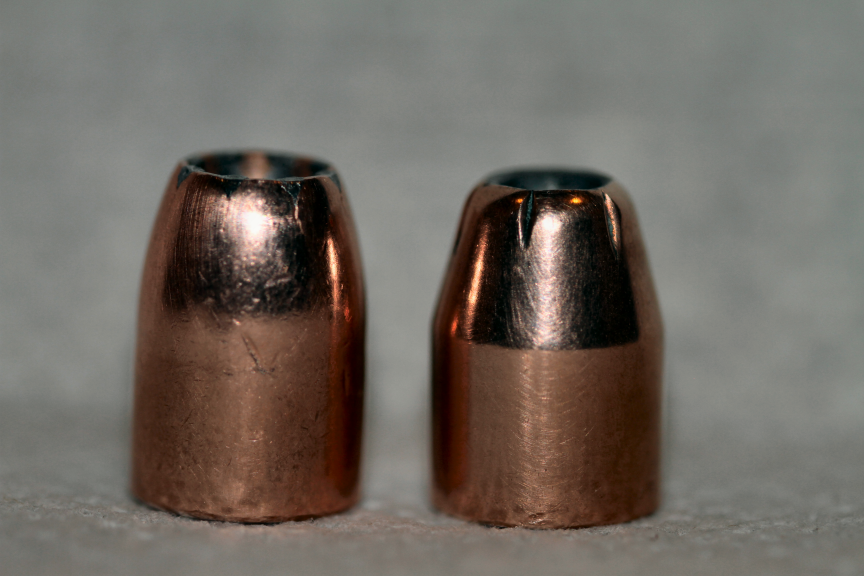You are using an out of date browser. It may not display this or other websites correctly.
You should upgrade or use an alternative browser.
You should upgrade or use an alternative browser.
Powder loads for FMJ, copper jackets, XTP
- Thread starter drholmes
- Start date
Welcome to TFL.
I don't have a Lee manual, so I can't see it directly.
One major factor that can change load data among bullets of the same weight is how deep the bullet seats into the case. The deeper the bullet sits inside the case, the quicker pressure builds upon ignition. All else being equal, it's like the powder having a faster burn rate - and correspondingly higher peak pressure.
More specific information could bring us closer to a less generalized answer.
I don't have a Lee manual, so I can't see it directly.
One major factor that can change load data among bullets of the same weight is how deep the bullet seats into the case. The deeper the bullet sits inside the case, the quicker pressure builds upon ignition. All else being equal, it's like the powder having a faster burn rate - and correspondingly higher peak pressure.
More specific information could bring us closer to a less generalized answer.
Jim Watson
New member
Lee copied the data from different sources - they do no testing themselves - and three different PV guns with three different bullets and three different sets of other components got three different answers.
There is not much you can do about it.
Either reload by recipe for the EXACT set of components you have, or apply handloading principles and sneak up on a serviceable load.
A chronograph to tell me when I am at a desired velocity is essential to the way I go about loading.
There is not much you can do about it.
Either reload by recipe for the EXACT set of components you have, or apply handloading principles and sneak up on a serviceable load.
A chronograph to tell me when I am at a desired velocity is essential to the way I go about loading.
As Jim points out the Lee Load Data is a compilation of other load data and Lee does no load testing. Not a bad thing but not quite a good thing either. Just worth knowing.
Below are pictured a 230 grain Hornady XTP and a 230 grain Speer Gold Dot, two very similar bullets but they are not the same length, close but not the same and they share a common 230 grain weight.

Hornady suggest a C.O.L. of 1.210"
Speer suggest a C.O.L. of 1.200"
So we have a difference of 0.010" difference in the suggested C.O.L. The 230 grain Hornady XTP has a bullet O.A.L. of right around 0.635" and is pictured on the right and the Speer Gold Dot on the Left comes in with an O.A.L. right around 0.655" or about 0.020" longer than the Hornady bullet but the suggested C.O.L. difference is only 0.010".
Starting and Maximum loads are suggested based on the test methods used by the original publisher of the data based on their test and test setups. For example, taking a real common .45 ACP powder like Unique and the 230 grain bullets we just looked at:
Hornady Start 5.2 grains and Maximum 6.6 grains ranging from 700 to 900 FPS fired from a Springfield 1911 5.0" barrel.
Speer Start 5.4 grains and Maximum 6.0 grains ranging from 721 to 806 FPS fired from a Sig P-220 4.4" barrel.
Each bullet maker has their own data suggested for their bullet. The main idea being to start safe and stay safe working up your loads. Again, the Lee data is a broad compilation of published data of everyone else.
Hope that helps and doesn't lend to confuse
Ron
Below are pictured a 230 grain Hornady XTP and a 230 grain Speer Gold Dot, two very similar bullets but they are not the same length, close but not the same and they share a common 230 grain weight.

Hornady suggest a C.O.L. of 1.210"
Speer suggest a C.O.L. of 1.200"
So we have a difference of 0.010" difference in the suggested C.O.L. The 230 grain Hornady XTP has a bullet O.A.L. of right around 0.635" and is pictured on the right and the Speer Gold Dot on the Left comes in with an O.A.L. right around 0.655" or about 0.020" longer than the Hornady bullet but the suggested C.O.L. difference is only 0.010".
Starting and Maximum loads are suggested based on the test methods used by the original publisher of the data based on their test and test setups. For example, taking a real common .45 ACP powder like Unique and the 230 grain bullets we just looked at:
Hornady Start 5.2 grains and Maximum 6.6 grains ranging from 700 to 900 FPS fired from a Springfield 1911 5.0" barrel.
Speer Start 5.4 grains and Maximum 6.0 grains ranging from 721 to 806 FPS fired from a Sig P-220 4.4" barrel.
Each bullet maker has their own data suggested for their bullet. The main idea being to start safe and stay safe working up your loads. Again, the Lee data is a broad compilation of published data of everyone else.
Hope that helps and doesn't lend to confuse
Ron
Thanks for input. I can understand variations in pressure related to bullet seating depth which can be effected by overall bullet length but I guess my real question is whether there is differences in the coefficient of expansion of copper plated vs full metal jacketed and do hollow points expand relatively more because there might be less resistance to expansion? I know this probably makes little practical difference but I just would like to understand the physics.
